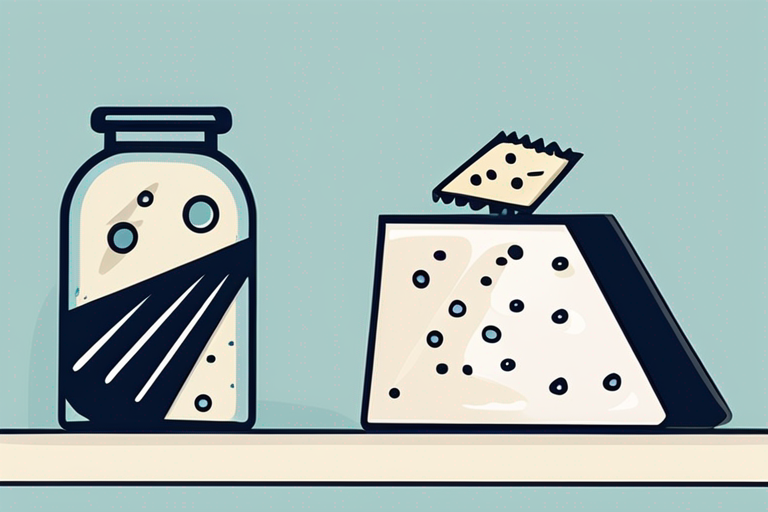
How to Extend the Shelf Life of Your Blue Cheese Wedge
Get Your Free Food Safety Cheat Sheet
30 most common foods with instant answers. Print it and stick it on your fridge—completely free!
How to Extend the Shelf Life of Your Blue Cheese Wedge
Blue cheese is a delicious and flavorful cheese that can add a unique touch to salads, sandwiches, and other dishes. However, like all dairy products, blue cheese has a limited shelf life and can spoil if not stored properly. In this blog post, we will discuss some practical tips on how you can extend the shelf life of your blue cheese wedge and keep it fresh for longer.
Understanding Blue Cheese Shelf Life
Blue cheese is a type of cheese that has been inoculated with Penicillium mold, which gives it its distinctive blue veins and tangy flavor. Due to its mold content, blue cheese has a shorter shelf life compared to other types of cheese. Typically, an unopened blue cheese wedge can last for 2-3 weeks in the refrigerator, while once opened, it should be consumed within 1-2 weeks for the best quality.
Factors Affecting Blue Cheese Shelf Life
Several factors can affect the shelf life of blue cheese, including:
- Storage Temperature: Blue cheese should be stored at the proper temperature to prevent bacterial growth and mold development.
- Moisture Levels: Excess moisture can promote mold growth on blue cheese, leading to spoilage.
- Air Exposure: Exposure to air can cause blue cheese to dry out and lose its flavor.
- Cross-Contamination: Blue cheese should be stored away from other strong-smelling foods to prevent flavor transfer.
Tips for Extending Blue Cheese Shelf Life
To extend the shelf life of your blue cheese wedge and keep it fresh for longer, follow these practical tips:
1. Proper Storage
- Store blue cheese in its original packaging or wrap it tightly in wax paper or aluminum foil to prevent moisture loss.
- Place the wrapped blue cheese wedge in an airtight container or resealable plastic bag to minimize air exposure.
- Keep blue cheese in the refrigerator at a consistent temperature of around 35-45°F (1-7°C) to slow down bacterial growth.
2. Avoid Freezing Blue Cheese
- Freezing blue cheese can alter its texture and flavor, leading to a crumbly and less appetizing consistency.
- If you need to store blue cheese for an extended period, it's best to vacuum-seal it or use a cheese storage bag designed to preserve its freshness.
3. Check for Spoilage Signs
- Inspect the blue cheese wedge regularly for any signs of mold growth, discoloration, or off odors.
- If you notice any mold on the surface of the cheese, you can trim it off with a clean knife before consuming the remaining portion.
4. Use Cheese Paper
- Consider investing in cheese paper, which is specially designed to allow cheese to breathe while maintaining optimal moisture levels.
- Cheese paper can help prevent blue cheese from drying out or developing off flavors due to excess moisture.
5. Store Blue Cheese Away from Strong Odors
- Blue cheese can absorb odors from other foods in the refrigerator, affecting its flavor.
- Keep blue cheese in a separate cheese drawer or compartment away from strong-smelling foods like onions, garlic, or fish.
Conclusion
By following these tips for proper storage and handling, you can extend the shelf life of your blue cheese wedge and enjoy its rich flavor for longer. Remember to check the cheese regularly for any signs of spoilage and consume it within the recommended time frame for the best quality. With the right care and storage conditions, your blue cheese can stay fresh and delicious until the last bite.

Authoritative Food Safety References
These agencies and university labs inform every tip and health precaution we publish.
USDA FoodKeeper – Cold Storage Guidelines
Official refrigerator, freezer, and pantry timelines maintained by the U.S. Department of Agriculture.
Visit USDA FoodKeeperFDA Produce Safety Rule & Grower Guidance
Field-to-fridge handling practices that prevent contamination of fruits, vegetables, and leafy greens.
Visit FDA Produce SafetyCDC Foodborne Illness Prevention Hub
Surveillance-backed guidance on pathogens, symptoms, and steps to reduce foodborne illness risk.
Visit CDC Food SafetyUC Davis Postharvest Technology Center
University research detailing optimal storage atmospheres for produce after harvest.
Visit UC Davis PostharvestPenn State Extension – Home Food Preservation & Safety
Peer-reviewed extension bulletins on safe canning, chilling, and reheating practices.
Visit Penn State ExtensionCan I freeze my blue cheese wedge to make it last longer?
How do I know if my blue cheese wedge has gone bad?
Can I use expired blue cheese in cooking?
How long can I keep an opened blue cheese wedge in the refrigerator?
Get Your Free Food Safety Cheat Sheet
30 most common foods with instant answers. Print it and stick it on your fridge—completely free! Want more? Upgrade to the complete guide with 70+ foods.
Scan your food directly and get instant safety info using our AI-powered camera feature.